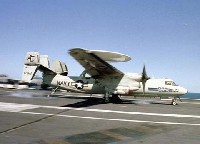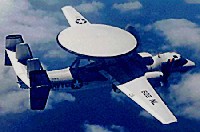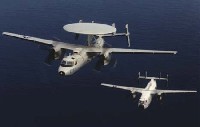|
Global Aircraft -- E-2 Hawkeye
Aviation Center
US Attack
US Bombers
US Cargo
US Fighters
US Helicopters
US Patrol/Pursuit
US Reconnaissance
US Tankers
US Trainers
US UAV's
US X Planes
Orbiter Vehicles
WWI Aircraft
WWII Aircraft
Airbus
Antonov
Boeing
Dassault
Ilyushin
Kamov
MiG
Mil
Saab
Sukhoi
Tupolev
Yakovlev
Joint/Rest of World
Entertainment Center
Members Center
New Technologies
Contact Us
Extra Navigation
GAC Engine
E-2 Hawkeye Specifications
E-2 Hawkeye Features
The Hawkeye provides all-weather airborne early warning and command and control functions for the carrier battle group. Additional missions include surface surveillance coordination, strike and interceptor control, search and rescue guidance and communications relay. An integral component of the carrier air wing, the E-2C uses computerized sensors to provide early warning, threat analyses and control of counteraction against air and surface targets. It is a high-wing aircraft with stacked antennae elements contained in a 24-foot rotating dome above the fuselage. The peculiar airflow over and around the radar dome led to a multiple-surface tail unit. Source: http://www.chinfo.navy.mil
E-2 Hawkeye Background
The continuous improvements in early airborne radars by 1956 led to the concept of an airborne early warning and command and control aircraft. The first aircraft to perform this mission was the Grumman E-1 Tracer (a variant of the S-2 Tracker anti-submarine aircraft), which saw service from 1954 to 1964. The E-1's successor, the E-2 Hawkeye, was the first carrier-based aircraft designed from the outset for the all-weather airborne early warning and command and control function. Since replacing the E-1 in 1964, the Hawkeye has been the "eyes of the fleet." Since its combat debut during the Vietnam conflict, the E-2 has served the Navy around the world. Hawkeyes directed F-14 Tomcat fighters flying combat air patrol during the two-carrier battle group joint strike against terrorist-related Libyan targets in 1986. E-2Cs and AEGIS cruisers, working together, provided total air mass superiority over the American fleet. More recently, E-2Cs provided the command and control for successful operations during the Persian Gulf War, directing both land attack and combat air patrol missions over Iraq and providing control for the shoot-down of two Iraqi MIG-21 aircraft by carrier-based F/A-18s in the early days of the war. E-2 aircraft also have worked extremely effectively with U.S. law enforcement agencies in drug interdictions. The newest version of the Hawkeye, the E-2C, became operation in 1973. Source: http://www.chinfo.navy.mil
| ||||||||||||||||||||||||||||||||||||||




